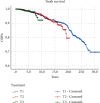Long-Term Follow-Up of Nonsurgical Endodontic Treatments Performed by One Specialist: A Retrospective Cohort Study about Tooth Survival and Treatment Success
- PMID: 33299417
- PMCID: PMC7704179
- DOI: 10.1155/2020/8855612
Long-Term Follow-Up of Nonsurgical Endodontic Treatments Performed by One Specialist: A Retrospective Cohort Study about Tooth Survival and Treatment Success
Abstract
Background: The main aim of the retrospective cohort study was to evaluate tooth survival after the endodontic treatment over a period of more than 20 years. Moreover, success of the treatment and the correlation between baseline parameters and the outcomes were analyzed, and causes were recorded.
Materials and methods: Clinical records (including radiographs) of subjects treated with endodontic procedures (both primary and secondary (nonsurgical retreatment)) were collected and analyzed, covering a period of up to 29 years. Type of the treatment, technique, adequacy of treatment performed, presence of baseline radiolucency, and symptoms at baseline were recorded. Moreover, failure (presence of radiolucency 2 years after treatment) and tooth extraction data and causes of them were recorded. Outcomes were explored by using survival analysis (Kaplan-Meier estimates and survival table analysis) and regression analysis (Cox regression).
Results: A total of 2,679 endodontically treated teeth were included in the analysis. After 20 years from the treatment, the cumulative survival rate for primary and secondary treatments was 84.10% (80.99%-87.21%) and 89.79% (86.68%-92.90%), respectively. No differences were found between primary and secondary treatments or with regard to the technique adopted. The presence of periapical radiolucency was correlated to higher odds of tooth extraction.
Conclusions: Despite the limitations of the study, we can assume that the proportion of retained endodontically treated teeth was significantly high over a long-term period.
Copyright © 2020 Paolo Mareschi et al.
Conflict of interest statement
The authors deny any conflicts of interest related to this study.
Figures
Similar articles
-
Endodontic retreatment versus dental implants of teeth with an uncertain endodontic prognosis: 3-year results from a randomised controlled trial.Eur J Oral Implantol. 2018;11(4):423-438. Eur J Oral Implantol. 2018. PMID: 30515483 Clinical Trial.
-
The prognosis of root canal therapy: a 10-year retrospective cohort study on 411 patients with 1175 endodontically treated teeth.Eur J Oral Implantol. 2009 Autumn;2(3):201-8. Eur J Oral Implantol. 2009. PMID: 20467630
-
Endodontic retreatment vs dental implants of teeth with an uncertain endodontic prognosis: 1-year results from a randomised controlled trial.Eur J Oral Implantol. 2017;10(3):293-308. Eur J Oral Implantol. 2017. PMID: 28944357 Clinical Trial.
-
Direct and Indirect Restorations for Endodontically Treated Teeth: A Systematic Review and Meta-analysis, IAAD 2017 Consensus Conference Paper.J Adhes Dent. 2018;20(3):183-194. doi: 10.3290/j.jad.a40762. J Adhes Dent. 2018. PMID: 29984369
-
Limitations of previously published systematic reviews evaluating the outcome of endodontic treatment.Int Endod J. 2009 Aug;42(8):656-66. doi: 10.1111/j.1365-2591.2009.01600.x. Epub 2009 Jun 22. Int Endod J. 2009. PMID: 19548929 Review.
Cited by
-
Ex vivo investigation on the effect of minimally invasive endodontic treatment on vertical root fracture resistance and crack formation.Sci Rep. 2024 Jun 8;14(1):13205. doi: 10.1038/s41598-024-63396-y. Sci Rep. 2024. PMID: 38851745 Free PMC article.
-
Repopulation of a 3D simulated periapical lesion cavity with dental pulp stem cell spheroids with triggered osteoblastic differentiation.Braz Dent J. 2024 Dec 16;35:e235847. doi: 10.1590/0103-644020235847. eCollection 2024. Braz Dent J. 2024. PMID: 39699491 Free PMC article.
-
Efficacy of Removing Thermafil and GuttaCore from Straight Root Canal Systems Using a Novel Non-Surgical Root Canal Re-Treatment System: A Micro-Computed Tomography Analysis.J Clin Med. 2021 Mar 18;10(6):1266. doi: 10.3390/jcm10061266. J Clin Med. 2021. PMID: 33803810 Free PMC article.
-
Survival of endodontically treated teeth in public dental service in Northern Finland: a practise-based register study.Acta Odontol Scand. 2024 Apr 25;83:190-196. doi: 10.2340/aos.v83.40491. Acta Odontol Scand. 2024. PMID: 38660831 Free PMC article.
-
Outcomes and predictive factors of vital pulp therapy in a large-scale retrospective cohort study over 10 years.Sci Rep. 2024 Jan 24;14(1):2063. doi: 10.1038/s41598-024-52654-8. Sci Rep. 2024. PMID: 38267594 Free PMC article.
References
-
- Friedman S. Prognosis of initial endodontic therapy. Endodontic Topics. 2002;2(1):59–88. doi: 10.1034/j.1601-1546.2002.20105.x. - DOI
-
- Schilder H. Cleaning and shaping the root canal. Dental Clinics of North America. 1974;18(2):269–296. - PubMed
-
- Friedman S., Mor C. The success of endodontic therapy-healing and functionality. Journal of the California Dental Association. 2004;32(6):493–503. - PubMed





